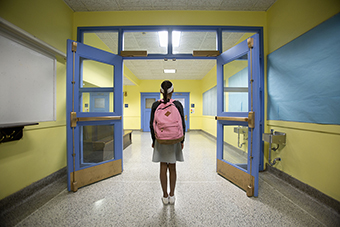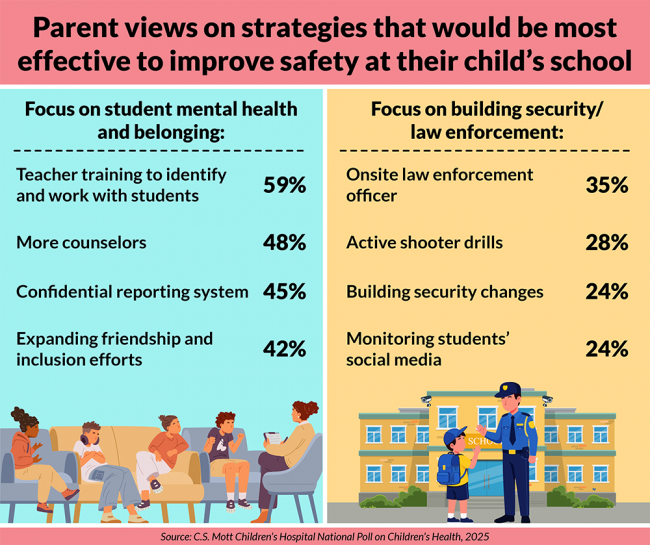Strategies for school safety


Strategies for school safety
Children learn best when they are in a safe learning environment. A variety of situations and potential threats can make students feel unsafe at school. The C.S. Mott Children’s Hospital National Poll on Children’s Health asked a national sample of parents of children 6-12 about safety issues at the school their child is attending for the 2025-26 school year.
Parents rate themselves as extremely (7%), very (9%), somewhat (33%), or minimally (52%) concerned about safety at their child’s school. Parents consider school safety to include bullying (76%), students fighting with other students (54%), an intruder bringing a weapon onto school grounds (51%), shooting by a student or school staff member (46%), cyberbullying (46%), student assault of teachers (31%), rape or sexual assault (25%), vandalism or theft (25%), and physical punishment of students (19%).
Parents cite the major factors that contribute to safety issues at their child’s school as lack of parent supervision (37%), children getting access to weapons (29%), not enough services for children who are struggling (28%), mental health problems among students (27%), inadequate security on school grounds (22%), and inadequate discipline by school staff (15%). In handling students who may cause safety problems, parents say their child’s school is doing too little to hold parents accountable (27%), provide mental health services (23%), help students make friends (19%), and suspend/expel students (15%).
For strategies that would be effective in improving safety, parents endorse teacher training to identify and work with students who have problems (59%), having more counselors (48%), having a confidential reporting system to identify students with problems (45%), expanding friendship and inclusion efforts (42%), having an onsite law enforcement officer (35%), offering more family counseling options (31%), holding active shooter drills (28%), making building security changes (24%), or asking school officials to monitor students’ social media (24%).
For an overall approach, only 8% of parents feel their child’s school should focus on building security and law enforcement; 33% support a focus on student mental health and belonging; and 59% endorse an equal mix of both approaches. Parents extremely or very concerned about school safety are more likely to want a focus on security and law enforcement.

Highlights
- 1 in 6 parents rate themselves as extremely or very concerned about safety at their child’s school.
- To address school safety issues, 3 in 5 parents endorse an equal focus of building security/law enforcement and student mental health/belonging.
- 1 in 4 parents feel their child’s school is doing too little to hold parents accountable for students who may cause safety problems.
Implications
The general public often equates school safety with terrifying images of school shootings. In this Mott Poll, that view is challenged by the responses of parents of children in elementary and middle school. While parents certainly include shootings as one component of school safety, they also believe safety is a continuum that encompasses negative interactions that routinely occur between students, such as bullying and cyberbullying, as well as physical altercations.
In describing both the causes and potential solutions for school safety issues, most parents pointed to students who need mental health services and other support to manage their emotions, improve their interpersonal skills, and find where they belong within the school community. Parents expressed the strongest support for additional training to help teachers learn how to identify and work with students whose problems may heighten their risk of hurting themselves or others. Classroom teachers see children on a daily basis and are well-positioned to notice changes in student moods and behaviors. Training can help teachers learn effective techniques to talk with students in active distress, and to know signs that a student should be referred for more extensive assessment and therapy. Parents also expressed strong support for additional counselors in the school setting, so there is no delay in getting help to students who need it.
An unexpected finding is that many parents feel that efforts to address school safety should include strategies to promote friendship and belonging. At first glance, these do not appear to be related to school safety. Yet parents seem to understand that children who feel isolated and excluded may be more likely to act out and cause problems. Parents may hear their child describe an incident from the school day, have a conversation with another parent concerned about their child’s lack of friends, or see a child all alone while their peers are having fun on the playground. These interactions prompt parents to realize that some children need help finding their place at school, which often involves learning to manage their emotions and behaviors; when the right type of help is given, the learning environment improves for all children.
The parents who participated in this Mott Poll also viewed other parents as contributing to school safety issues, in terms of a lack of discipline and allowing access to weapons. One-quarter felt the school did too little to hold parents accountable when their children caused safety problems at school. Accountability can be challenging for school officials: they want to keep students and their parents engaged and willing to participate in counseling and other services to improve student behavior; however, they may get pushback when there appear to be no consequences for repeated infractions.
Only one in six parents rated themselves as being extremely or very concerned about school safety. This group favored traditional school safety strategies, such as onsite law enforcement, active shooter drills, and enhanced building security. It’s plausible that parents who rate themselves as less concerned about school safety are instead prioritizing a positive school climate. Parents also may see some strategies, such as active shooter drills or armed security guards, as scary to children; this creates a paradox where the mechanisms implemented to keep children safe make them feel unsafe and less able to learn.
Overall, these findings indicate that parents of elementary and middle school students see school safety primarily as a day-to-day process of supporting the mental health and social needs of all children. School building- and district-level officials should solicit and consider the views of parents as they decide what safety measures to adopt.

Data Source & Methods
This report presents findings from a nationally representative household survey conducted exclusively by Ipsos Public Affairs, LLC (Ipsos) for C.S. Mott Children’s Hospital. The survey was administered in August 2025 to a randomly selected, stratified group of adults who were parents of at least one child age 1-17 years living in their household (n=2,029). Adults were selected from Ipsos’s web-enabled KnowledgePanel® that closely resembles the U.S. population. The sample was subsequently weighted to reflect population figures from the Census Bureau. The survey completion rate was 66% among panel members contacted to participate. This report is based on responses from 1,000 parents with at least one child age 6-12. The margin of error for results presented in this report is ±2 to 3 percentage points.
Findings from the C.S. Mott Children’s Hospital National Poll on Children’s Health do not represent the opinions of the University of Michigan. The University of Michigan reserves all rights over this material.
Citation
Clark SJ, Heinze J, Schultz SL, Gebremariam A, Woolford SJ. Strategies for school safety. C.S. Mott Children's Hospital National Poll on Children's Health, University of Michigan. Vol 48, Issue 3, November 2025. Available at: https://mottpoll.org/reports/strategies-school-safety.

